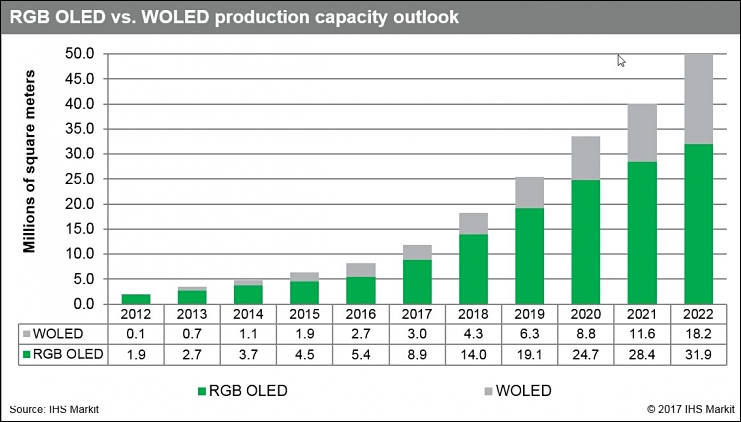
-

In the current, unprecedented phase of active matrix organic light emitting diode (AMOLED) panel factory build-out, flexible AMOLED capacity will expand from 1.5 million square meters to 20.1 million square meters between 2016 and 2020, at a compound annual growth rate of 91 percent. In 2016, flexible capacity, or factories with the ability to produce AMOLEDs on plastic substrates, only accounted for 28 percent of total capacity targeting mobile applications. This will increase to 80 percent by 2020 as almost every new Gen 6 fab and smaller factory built over the next four years will be flexible compatible,
To absorb all the new capacity in the pipeline, flexible AMOLED panels will need to expand the market beyond smartphones to tablet PCs, notebooks and new form factors enabled by foldable displays. Ultimately, the rapid growth of flexible AMOLED capacity and the resulting increase in panel production will help to lower costs, increase yields and improve quality. In the long-run, this will spur further adoption into more applications; however, to get there, the industry may first need to cycle through a difficult period of digesting the 46 new flexible fabs now being built.
-
I am really a supporter of AMOLED (as I really like black levels and contrast). However has the burn-in issue been fixed yet? It's horrible to walk into mobile phone shops and see burned in OLED screens. :-(
Howdy, Stranger!
It looks like you're new here. If you want to get involved, click one of these buttons!
Categories
- Topics List23,992
- Blog5,725
- General and News1,354
- Hacks and Patches1,153
- ↳ Top Settings33
- ↳ Beginners256
- ↳ Archives402
- ↳ Hacks News and Development56
- Cameras2,367
- ↳ Panasonic995
- ↳ Canon118
- ↳ Sony156
- ↳ Nikon96
- ↳ Pentax and Samsung70
- ↳ Olympus and Fujifilm101
- ↳ Compacts and Camcorders300
- ↳ Smartphones for video97
- ↳ Pro Video Cameras191
- ↳ BlackMagic and other raw cameras116
- Skill1,960
- ↳ Business and distribution66
- ↳ Preparation, scripts and legal38
- ↳ Art149
- ↳ Import, Convert, Exporting291
- ↳ Editors191
- ↳ Effects and stunts115
- ↳ Color grading197
- ↳ Sound and Music280
- ↳ Lighting96
- ↳ Software and storage tips266
- Gear5,420
- ↳ Filters, Adapters, Matte boxes344
- ↳ Lenses1,582
- ↳ Follow focus and gears93
- ↳ Sound499
- ↳ Lighting gear314
- ↳ Camera movement230
- ↳ Gimbals and copters302
- ↳ Rigs and related stuff273
- ↳ Power solutions83
- ↳ Monitors and viewfinders340
- ↳ Tripods and fluid heads139
- ↳ Storage286
- ↳ Computers and studio gear560
- ↳ VR and 3D248
- Showcase1,859
- Marketplace2,834
- Offtopic1,320







